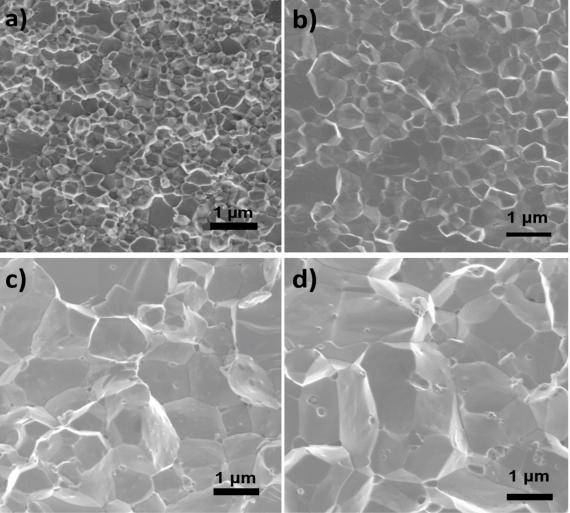Researchers report new thermoelectric material with high power factors

SEM images of the material hot-pressed at a) 1123 K, b)1173 K, c) 1273 K, and d)1373 K. Credit: University of Houston
With energy conservation expected to play a growing role in managing global demand, materials and methods that make better use of existing sources of energy have become increasingly important.
Researchers reported this week in the Proceedings of the National Academy of Sciences that they have demonstrated a step forward in converting waste heat – from industrial smokestacks, power generating plants or even automobile tailpipes – into electricity.
The work, using a thermoelectric compound composed of niobium, titanium, iron and antimony, succeeded in raising the material's power output density dramatically by using a very hot pressing temperature – up to 1373 Kelvin, or about 2,000 degrees Fahrenheit – to create the material.
“The majority of industrial energy input is lost as waste heat,” the researchers wrote. “Converting some of the waste heat into useful electrical power will lead to the reduction of fossil fuel consumption and CO2 emission.”
Thermoelectric materials produce electricity by exploiting the flow of heat current from a warmer area to a cooler area, and their efficiency is calculated as the measure of how well the material converts heat – often waste heat generated by power plants or other industrial processes – into power. For example, a material that takes in 100 watts of heat and produces 10 watts of electricity has an efficiency rate of 10 percent.
That's the traditional way of considering thermoelectric materials, said Zhifeng Ren, MD Anderson Professor of Physics at the University of Houston and lead author of the paper. But having a relatively high conversion efficiency doesn't guarantee a high power output, which measures the amount of power produced by the material rather than the rate of the conversion.
Because waste heat is an abundant – and free – source of fuel, the conversion rate is less important than the total amount of power that can be produced, said Ren, who is also a principal investigator at the Texas Center for Superconductivity at UH. “In the past, that has not been emphasized.”
In addition to Ren, researchers involved in the project include Ran He, Jun Mao, Qing Jie, Jing Shuai, Hee Seok Kim, Yuan Liu and Paul C.W. Chu, all of UH; Daniel Kraemer, Lingping Zeng and Gang Chen of the Massachusetts Institute of Technology; Yucheng Lan of Morgan State University, and Chunhua Li and David Broido of Boston College.
The researchers tweaked a compound made up of niobium, iron and antimony, replacing between 4 and 5 percent of the niobium with titanium. Processing the new compound at a variety of high temperatures suggested that a very high temperature – 1373 Kelvin – resulted in a material with an unusually high power factor.
“For most thermoelectric materials, a power factor of 40 is good,” Ren said. “Many have a power factor of 20 or 30.”
The new material has a power factor of 106 at room temperature, and researchers were able to demonstrate an output power density of 22 watts per square centimeter, far higher than the 5 to 6 watts typically produced, he said.
“This aspect of thermoelectrics needs to be emphasized,” he said. “You can't just look at the efficiency. You have to look also at the power factor and power output.”
Media Contact
All latest news from the category: Materials Sciences
Materials management deals with the research, development, manufacturing and processing of raw and industrial materials. Key aspects here are biological and medical issues, which play an increasingly important role in this field.
innovations-report offers in-depth articles related to the development and application of materials and the structure and properties of new materials.
Newest articles

First-of-its-kind study uses remote sensing to monitor plastic debris in rivers and lakes
Remote sensing creates a cost-effective solution to monitoring plastic pollution. A first-of-its-kind study from researchers at the University of Minnesota Twin Cities shows how remote sensing can help monitor and…

Laser-based artificial neuron mimics nerve cell functions at lightning speed
With a processing speed a billion times faster than nature, chip-based laser neuron could help advance AI tasks such as pattern recognition and sequence prediction. Researchers have developed a laser-based…

Optimising the processing of plastic waste
Just one look in the yellow bin reveals a colourful jumble of different types of plastic. However, the purer and more uniform plastic waste is, the easier it is to…



